AI-Based Susceptibility Analysis of Shallow Landslides Induced by Heavy Rainfall in Tianshui, China
Abstract
1. Introduction
2. Study Area
3. Methods
3.1. Landslide Inventory and Mapping
3.2. Landslide Susceptibility Evaluation Based on Machine Learning
3.2.1. Selection of Factors Influencing Landslides
Parameters Related to Geomorphological Conditions
Parameters Related to Landslide Materials and Geological Conditions
3.2.2. Parameter Preprocessing
Parameters Related to Landslide Materials and Geological Conditions
Resampling
Data Standardization
3.2.3. Candidate Machine Selection
Ensemble Methods
Generalized Linear Models (GLMs)
Nearest Neighbors
Support Vector Machines (SVM)
Trees
Discriminant Analysis
eXtreme Gradient Boosting (XGBoost)
3.2.4. Model Fitting and Tuning
4. Results
4.1. Landslide Inventory and Mapping
4.2. Landslide Susceptibility Mapping
5. Discussion
6. Conclusions
- (1)
- The 21 initial models were trained with the training data in the cross-validation dataset, and the models were then sorted according to the average accuracy score (ACC). The results showed that the overall fitting effect of the comprehensive model was better than for the other models. The ExtraTrees model had the highest score, with an average test data accuracy of 0.91, and the average AUC after 10-times cross validation was 0.97. This model can be effectively used for the susceptibility evaluation of shallow landslides.
- (2)
- Among all of the selected evaluation factors, slope aspect made a larger contribution to landslide development than the other factors. For 94° < SA < 246°, LSs accounted for the highest proportion, which indicates that sunlit slopes are significantly more prone to landslides than shaded slopes, followed by PLC, DR, DTF, NDVI, and DTR. Geomorphic conditions are the most important factors in triggering landslides induced by heavy rainfall, followed by fluvial erosion and fault distribution, while human activities have only a small influence.
- (3)
- In the evaluation of landslide susceptibility based on machine learning, the prediction performance of various models is significantly different. Extensive comparative prediction in different environments, closely linking the model evaluation with the goals of the study and increasing the understanding of the ability and limitations of the model are the key to model selection in the future, so as to strengthen the application of artificial intelligence technology in the field of geological disaster prevention and improve the prediction accuracy and efficiency.
Author Contributions
Funding
Acknowledgments
Conflicts of Interest
References
- Keefer, D.K. Landslides caused by earthquakes. Geol. Soc. Am. Bull. 1984, 95, 406–421. [Google Scholar] [CrossRef]
- Guzzetti, F.; Cardinali, M.; Reichenbach, P.; Cipolla, F.; Sebastiani, C.; Galli, M.; Salvati, P. Landslides triggered by the 23 November 2000 rainfall event in the Imperia Province, Western Liguria, Italy. Eng. Geol. 2004, 73, 229–245. [Google Scholar] [CrossRef]
- Yamagishi, H.; Iwahashi, J. Comparison between the two triggered landslides in mid-Niigata, Japan by July 13 heavy rainfall and October 23 intensive earthquakes in 2004. Landslides 2007, 4, 389–397. [Google Scholar] [CrossRef]
- Owen, L.A.; Kamp, U.; Khattak, G.A.; Harp, E.L.; Keefer, D.K.; Bauer, M.A. Landslides triggered by the 8 October 2005 Kashmir Earthquake. Geomorphology 2008, 94, 1–9. [Google Scholar] [CrossRef]
- Sato, H.P.; Harp, E.L. Interpretation of earthquake-induced landslides triggered by the 12 May 2008, M7.9 Wenchuan earthquake in the Beichuan area, Sichuan Province, China using satellite imagery and Google Earth. Landslides 2009, 6, 153–159. [Google Scholar] [CrossRef]
- Pánek, T.; Brázdil, R.; Klime, J.; Smolková, V.; Hradeck, J.; Zahradníek, P. Rainfall-induced landslide event of May 2010 in the eastern part of the Czech Republic. Landslides 2011, 8, 507–516. [Google Scholar] [CrossRef]
- Romanowicz, B. Spatiotemporal patterns in the energy release of great earthquakes. Science 1993, 260, 1923–1926. [Google Scholar] [CrossRef][Green Version]
- Kirschbaum, D. Global Catalog of Rainfall-Triggered Landslides for Spatial and Temporal Hazard Characterization. In Landslide Science for a Safer Geoenvironment; Springer: Cham, Switzerland, 2014; pp. 809–814. [Google Scholar]
- Guzzetti, F.; Gariano, S.L. Landslides in a changing climate. Earth Sci. Rev. 2016, 162, 227–252. [Google Scholar]
- Hong, Y.; Adler, R.; Huffman, G. Evaluation of the potential of NASA multi-satellite precipitation analysis in global landslide hazard assessment. Geophys. Res. Lett. 2018, 33, 1–5. [Google Scholar] [CrossRef]
- Marc, O.; Stumpf, A.; Malet, J.P.; Gosset, M.; Uchida, T.; Chiang, S.H. Initial insights from a global database of rainfall-induced landslide inventories: The weak influence of slope and strong influence of total storm rainfall. Earth Surf. Dyn. 2018, 6, 903–922. [Google Scholar] [CrossRef]
- Fustos, I.; Abarca, D.R.R.; Yaeger, P.M.; Valenzuela, M.S. Rainfall-induced landslides forecast using local precipitation and global climate indexes. Nat. Hazards 2020, 102, 115–131. [Google Scholar] [CrossRef]
- Dai, F.C.; Lee, C.F.; Wang, S.J. Characterization of rainfall-induced landslides. Int. J. Remote Sens. 2003, 24, 4817–4834. [Google Scholar] [CrossRef]
- Chen, H.; Dadson, S.; Chi, Y.G. Recent rainfall-induced landslides and debris flow in northern Taiwan. Geomorphology 2006, 77, 112–125. [Google Scholar] [CrossRef]
- Guzzetti, F.; Reichenbach, P.; Cardinali, M.; Galli, M.; Ardizzone, F. Probabilistic landslide hazard assessment at the basin scale. Geomorphology 2005, 72, 272–299. [Google Scholar] [CrossRef]
- Haneberg, W.C.; Cole, W.F.; Kasali, G. High-resolution lidar-based landslide hazard mapping and modeling, UCSF Parnassus Campus, San Francisco, USA. Bull. Eng. Geol. Environ. 2009, 68, 263–276. [Google Scholar] [CrossRef]
- Larsen, I.J.; Montgomery, D.R. Landslide erosion coupled to tectonics and river incision. Nat. Geosci. 2012, 5, 468–473. [Google Scholar] [CrossRef]
- Guzzetti, F.; Mondini, A.C.; Cardinali, M.; Fiorucci, F.; Santangelo, M.; Chang, K.T. Landslide inventory maps: New tools for an old problem. Earth Sci. Rev. 2012, 112, 42–66. [Google Scholar] [CrossRef]
- Tanyaş, H.; Westen, C.J.; Allstadt, K.E.; Jibson, R.W. Factors controlling landslide frequency-area distributions. Earth Surf. Process. Landf. 2018, 44, 900–917. [Google Scholar] [CrossRef]
- Glenn, N.F.; Streutker, D.R.; Chadwick, D.J.; Thackray, G.D.; Dorsch, S.J. Analysis of LiDAR-derived topographic information for characterizing and differentiating landslide morphology and activity. Geomorphology 2006, 73, 131–148. [Google Scholar] [CrossRef]
- Santangelo, M.; Cardinali, M.; Rossi, M.; Mondini, A.C.; Guzzetti, F. Remote landslide mapping using a laser rangefinder binocular and GPS. Nat. Hazards Earth Syst. Sci. 2010, 10, 2539–2546. [Google Scholar] [CrossRef]
- Pánek, T.; Břežný, M.; Kapustová, V.; Lenart, J.; Chalupa, V. Large landslides and deep-seated gravitational slope deformations in the Czech Flysch Carpathians: New LiDAR-based inventory. Geomorphology 2019, 346, 1–18. [Google Scholar] [CrossRef]
- Huang, R. Large-scale landslide and their sliding mechanisms in China since the 20th Century. Chin. J. Rock Mech. Eng. 2007, 26, 433–454. [Google Scholar]
- Ayalew, L.; Yamagishi, H.; Ugawa, N. Landslide susceptibility mapping using GIS-based weighted linear combination, the case in Tsugawa area of Agano River, Niigata Prefecture, Japan. Landslides 2004, 1, 73–81. [Google Scholar] [CrossRef]
- Nefeslioglu, H.A.; Duman, T.Y.; Durmaz, S. Landslide susceptibility mapping for a part of tectonic Kelkit Valley (Eastern Black Sea region of Turkey). Geomorphology 2008, 94, 401–418. [Google Scholar] [CrossRef]
- Baeza, C.; Corominas, J. Assessment of shallow landslide susceptibility by means of multivariate statistical techniques. Earth Surf. Process. Landf. 2010, 26, 1251–1263. [Google Scholar] [CrossRef]
- Pradhan, B.; Lee, S. Regional landslide susceptibility analysis using back-propagation neural network model at Cameron Highland, Malaysia. Landslides 2010, 7, 13–30. [Google Scholar] [CrossRef]
- Demir, G. GIS-based landslide susceptibility mapping for a part of the North Anatolian fault Zone between Reşadiye and Koyulhisar (Turkey). Catena 2019, 183, 1–12. [Google Scholar] [CrossRef]
- Saha, A.K.; Gupta, R.P.; Sarkar, I.; Arora, M.K.; Csaplovics, E. An approach for GIS-based statistical landslide susceptibility zonation—with a case study in the Himalayas. Landslides 2005, 2, 61–69. [Google Scholar] [CrossRef]
- Yesilnacar, E.; Topal, T. Landslide susceptibility mapping: A comparison of logistic regression and neural networks methods in a medium scale study, Hendek Region (Turkey). Eng. Geol. 2005, 79, 251–266. [Google Scholar] [CrossRef]
- Goetz, J.N.; Brenning, A.; Petschko, H.; Leopold, P. Evaluating machine learning and statistical prediction techniques for landslide susceptibility modeling. Comput. Geosci. 2015, 81, 1–11. [Google Scholar] [CrossRef]
- Aditian, A.; Kubota, T.; Shinohara, Y. Comparison of GIS-based landslide susceptibilitymodels using frequency ratio, logistic regression, and artificial neural network in a tertiary region of Ambon, Indonesia. Geomorphology 2018, 318, 101–111. [Google Scholar] [CrossRef]
- Marjanović, M.; Kovačević, M.; Bajat, B.; Voženílek, V. Landslide susceptibility assessment using SVM machine learning algorithm. Eng. Geol. 2011, 123, 225–234. [Google Scholar] [CrossRef]
- Pham, B.T.; Bui, T.D.; Prakash, I.; Dholakia, M.B. Hybrid integration of multilayer perceptron neural networks and machine learning ensembles for landslide susceptibility assessment at Himalayan Area (India) using GIS. Catena 2017, 149, 52–63. [Google Scholar] [CrossRef]
- Feng, Q.; Zhao, Y.; Meng, X.; Su, X.; Qi, T.; Yue, D. Application of machine learning to debris flow susceptibility mapping along the China-Pakistan Karakoram highway. Remote Sens. 2020, 12, 2933. [Google Scholar]
- Napoli, M.D.; Carotenuto, F.; Cevasco, A.; Confuorto, P.; Calcaterra, D. Machine learning ensemble modelling as a tool to improve landslide susceptibility mapping reliability. Landslides 2020, 17, 1897–1914. [Google Scholar] [CrossRef]
- Zhao, Y.; Meng, X.; Qi, T.; Qing, F.; Chen, G. AI-based identification of low-frequency debris flow catchments in the Bailong River Basin, China. Geomorphology 2020, 359, 107–125. [Google Scholar] [CrossRef]
- Guo, F.; Meng, X.; Li, Z.; Xie, Z.; Chen, G.; He, Y. Characteristics and causes of assembled geo-hazards induced by the rainstorm on 25th July 2013 in Tianshui City, Gansu, China. Mt. Res. 2015, 1, 100–107. [Google Scholar]
- Dijkstra, T.A.; Rogers, C.D.F.; Smalley, I.J.; Derbyshire, E.; Li, Y.J.; Meng, X.M. The loess of north-Central China: Geotechnical properties and their relation to slope stability. Eng. Geol. 1994, 36, 153–171. [Google Scholar] [CrossRef]
- Wang, Z.; Kang, G.; Ma, C.; Miao, T. A study on the generating mechanism of vertical joints in loess. Int. J. Rock Mech. Min. Sci. Geomech. 1994, 31, 259–260. [Google Scholar]
- Sun, P.; Wang, G.; Wu, L.Z.; Lgwe, O.; Zhu, E. Physical model experiments for shallow failure in rainfall-triggered loess slope, Northwest China. Bull. Eng. Geol. Environ. 2019, 78, 43–63. [Google Scholar] [CrossRef]
- Tarolli, P.; Tarboton, D.G. A new method for determination of most likely landslide initiation points and the evaluation of digital terrain model scale in terrain stability mapping. Hydrol. Earth Syst. Sci. 2006, 10, 663–677. [Google Scholar] [CrossRef]
- Passalacqua, P.; Tarolli, P.; Foufoula, G.E. Testing space-scale methodologies for automatic geomorphic feature extraction from lidar in a complex mountainous landscape. Water Resour. Res. 2010, 46, 1–17. [Google Scholar] [CrossRef]
- Tarolli, P.; Sofia, G.; Fontana, G.D. Geomorphic features extraction from high-resolution topography: Landslide crowns and bank erosion. Nat. Hazards 2012, 61, 65–83. [Google Scholar] [CrossRef]
- Pandey, P. Inventory of rock glaciers in Himachal Himalaya, India using high-resolution Google Earth imagery. Geomorphology 2019, 340, 103–115. [Google Scholar] [CrossRef]
- Clague, J.J.; Stead, D. Landslides: Types, Mechanisms and Modeling; Cambridge University Press: Cambridge, UK, 2012; pp. 159–171. [Google Scholar]
- Carlini, M.; Chelli, A.; Francese, R.; Giacomelli, S.; Giorgi, M.; Quagliarini, A.; Carpena, A.; Tellini, C. Landslides types controlled by tectonics-induced evolution of valley slopes (northern Apennines, Italy). Landslides 2018, 15, 283–296. [Google Scholar] [CrossRef]
- Mishra, B.K.; Bhattacharjee, D.; Chattopadhyay, A.; Prusty, G. Tectonic and lithologic control over landslide activity within the Larji–Kullu tectonic window in the higher Himalayas of India. Nat. Hazards 2018, 92, 673–697. [Google Scholar] [CrossRef]
- Wang, J.; Liang, Y.; Zhang, H.; Wu, Y.; Lin, X. A loess landslide induced by excavation and rainfall. Landslides 2014, 11, 141–152. [Google Scholar] [CrossRef]
- Peng, J.; Fan, Z.; Wu, D.; Zhuang, J.; Dai, F.; Chen, W.; Zhao, C. Heavy rainfall triggered loess–mudstone landslide and subsequent debris flow in Tianshui, China. Eng. Geol. 2015, 186, 79–90. [Google Scholar] [CrossRef]
- Palladino, M.R.; Viero, A.; Turconi, L.; Brunetti, M.T.; Peruccacci, S.; Melillo, M.; Luino, F.; Deganutti, A.M.; Guzzetti, F. Rainfall thresholds for the activation of shallow landslides in the Italian Alps: The role of environmental conditioning factors. Geomorphology 2018, 303, 53–67. [Google Scholar] [CrossRef]
- Kanungo, D.P.; Sharma, S. Rainfall thresholds for prediction of shallow landslides around Chamoli-Joshimath region, Garhwal Himalayas, India. Landslides 2014, 11, 629–638. [Google Scholar] [CrossRef]
- Burnett, B.N.; Meyer, G.A.; Mcfadden, L.D. Aspect-related microclimatic influences on slope forms and processes, northeastern Arizona. J. Geophys. Res. Earth Surf. 2008, 113, 1–18. [Google Scholar] [CrossRef]
- Břežný, M.; Pánek, T. Deep-seated landslides affecting monoclinal flysch morphostructure: Evaluation of LiDAR-derived topography of the highest range of the Czech Carpathians. Geomorphology 2017, 285, 44–57. [Google Scholar] [CrossRef]
- Wilson, J.P.; Gallant, J.C. Terrain Analysis Principles and Applications; Wiley: Toronto, ON, Canada, 2000; p. 479. [Google Scholar]
- Alvioli, M.; Guzzetti, F.; Marchesini, I. Parameter-free delineation of slope units and terrain subdivision of Italy. Geomorphology 2020, 358, 107–124. [Google Scholar] [CrossRef]
- Gallart, F.; Clotet, P.N. Some aspects of the geomorphic processes triggered by an extreme rainfall event: The November 1982 flood in the eastern Pyrenees. Catena Suppl. 1988, 13, 79–95. [Google Scholar]
- Záruba, Q.; Mencl, V. Landslides and Their Control; Elsevier: Amsterdam, The Netherlands, 1969; p. 236. [Google Scholar]
- Okimura, T. A prediction system for the site of probable surface failure of mountain-slope by topographical factors. Proc. Jpn. Soc. Civil Eng. 1983, 338, 131–138. [Google Scholar] [CrossRef]
- Oyagi, N. Landslides in Weathered Rocks and Residual Soils in Japan and Surrounding Areas: A State of the Art Report. In Proceedings of the 4th International Symposium on Landslides, Toronto, ON, Canada, 16–21 September 1984; pp. 1–31. [Google Scholar]
- Stokes, A.; Atger, C.; Bengough, A.G.; Fourcaud, T.; Sidle, R.C. Desirable plant root traits for protecting natural and engineered slopes against landslides. Plant Soil 2009, 324, 1–30. [Google Scholar] [CrossRef]
- Tsou, C.; Chigira, M.; Matsushi, Y.; Chen, S. Deep-seated gravitational deformation ofmountain slopes caused by river incision in the Central Range, Taiwan: Spatial distribution and geological characteristics. Eng. Geol. 2015, 196, 126–138. [Google Scholar] [CrossRef]
- Chawla, N.V.; Bowyer, K.W.; Hall, L.O.; Kegelmeyer, W.P. Smote: Synthetic minorityover-sampling technique. J. Artif. Intell. Res. 2002, 16, 321–357. [Google Scholar] [CrossRef]
- Bisong, E. Introduction to Scikit-learn. In Building Machine Learning and Deep Learning Models on Google Cloud Platform; Apress: Berkeley, CA, USA, 2019; pp. 215–229. [Google Scholar]
- Korup, O. Distribution of landslides in southwest New Zealand. Landslides 2005, 2, 43–51. [Google Scholar] [CrossRef]
- Wu, T.F.; Lin, C.J.; Weng, R.C. Probability estimates for multi-class classification by pairwise coupling. J. Mach. Learn. Res. 2004, 5, 975–1005. [Google Scholar]
- Roy, J.; Saha, S.; Arabameri, A.; Blaschke, T.; Bui, D.T. A novel ensemble approach for landslide susceptibility mapping (ISM) in Darjeeling and Kalimpong districts, West Bengal, India. Remote Sens. 2019, 11, 2866. [Google Scholar] [CrossRef]
- Cooper, A.W. An example of the role of microclimate in soil genesis. Soil Sci. 1960, 90, 109–120. [Google Scholar] [CrossRef]
- Nevo, E.; Fragman, O.; Dafni, A.; Beiles, A. Biodiversity and interslope divergence of vascular plants caused by microclimate differences at “Evolution Canyon” lower nahal Oren, Mount Carmel, Israel. Isr. J. Plant Sci. 1999, 47, 49–59. [Google Scholar] [CrossRef]
- Xue, W.P.; Zhao, Z.; Li, P.; Cao, Y. Researches on root distribution characteristics of Robinia Pseudoacacia stand in Wangdonggou on different site conditions. J. Agric. Sci. Technol. 2003, 31, 27–32. [Google Scholar]
- Hussein, M.A. Changes in microstructure, voids and b-fabric of surface samples of a Vertisol caused by wet/dry cycles. Geoderma 1998, 85, 63–82. [Google Scholar] [CrossRef]
- Luiz, F.; Osny, O.S.; Bacchi, K.P. Gammaray computed tomography to evaluate wetting/drying soil structure changes. Nucl. Instrum. Methods Phys. Res. 2005, 229, 443–456. [Google Scholar]
- Begueria, S. Changes in land cover and shallow landslide activity: A case study in the Spanish Pyrenees. Geomorphology 2006, 74, 196–206. [Google Scholar] [CrossRef]
- Reid, M.; Iverson, R. Gravity-driven groundwater flow and slope failure potential 2. Effects of slope morphology, material properties, and hydraulic heterogeneity. Water Resour. Res. 1992, 3, 935–950. [Google Scholar] [CrossRef]
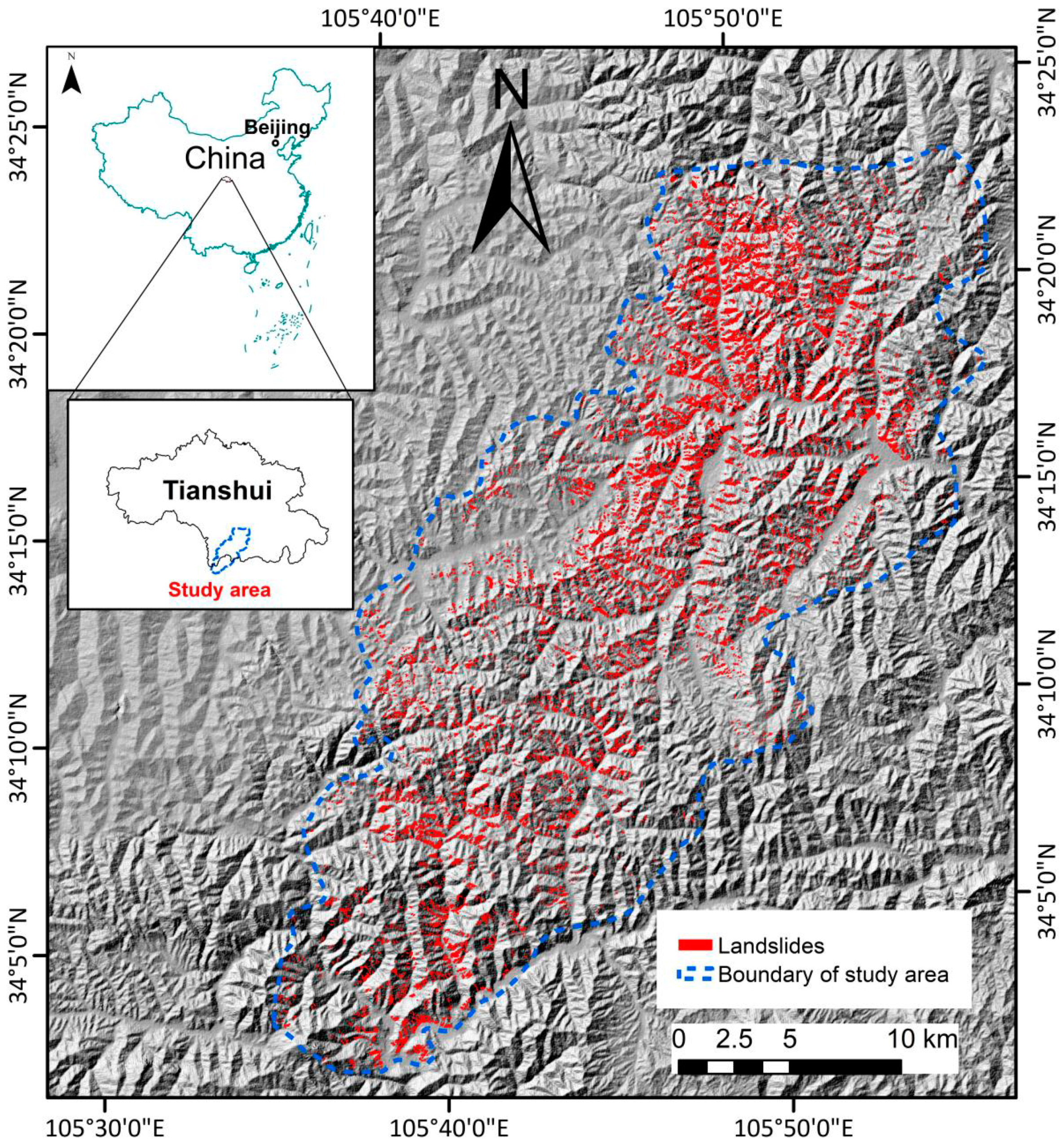
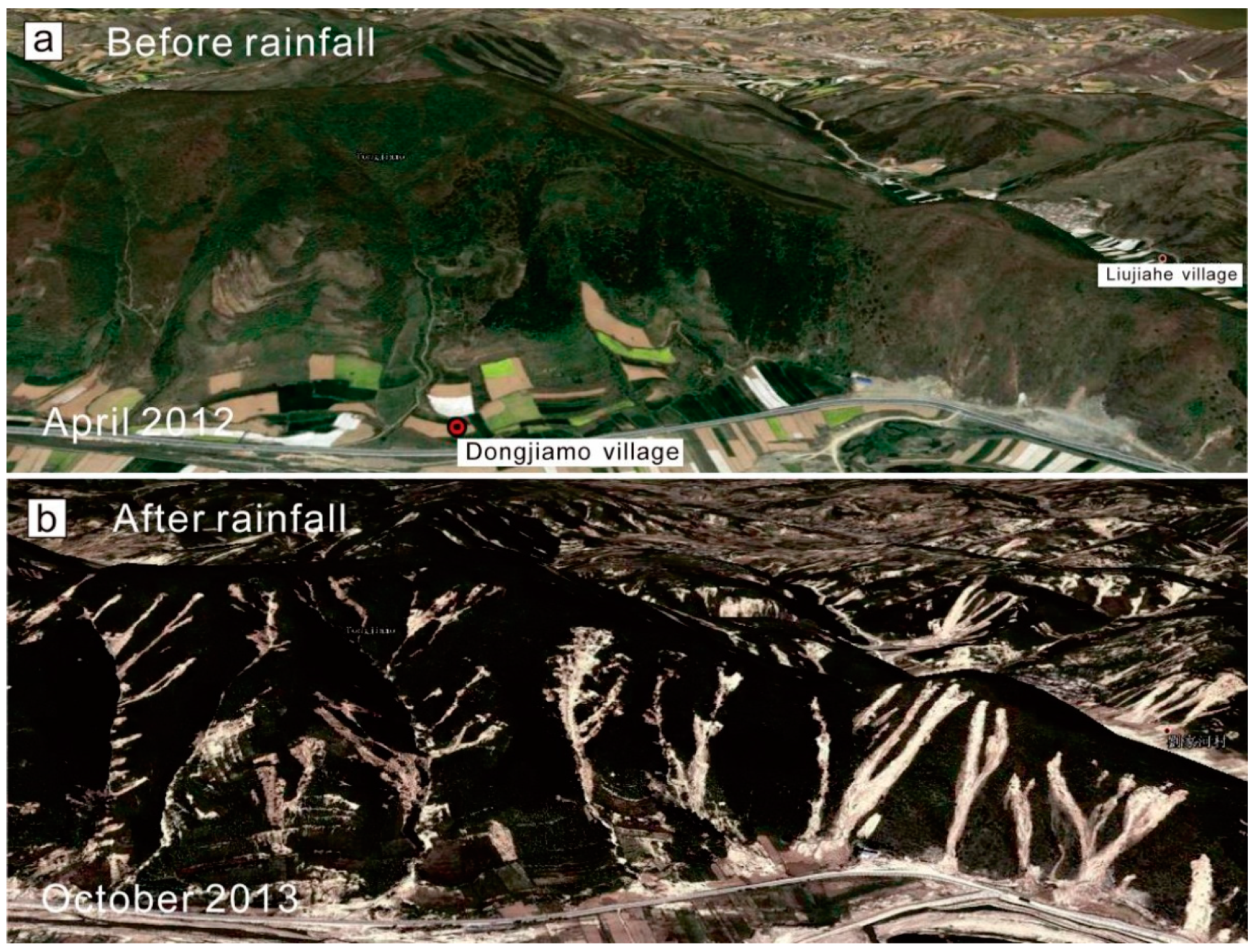
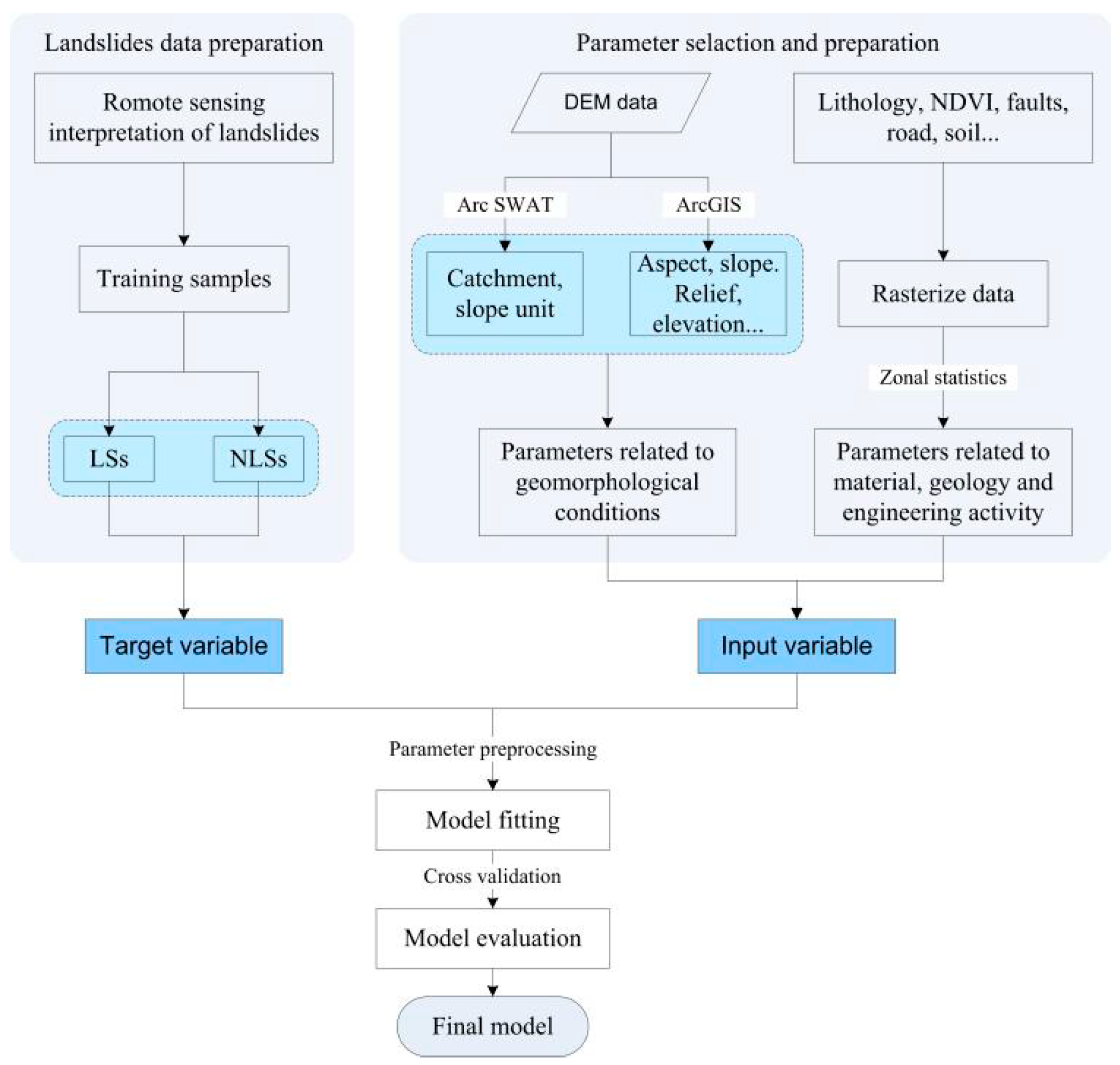


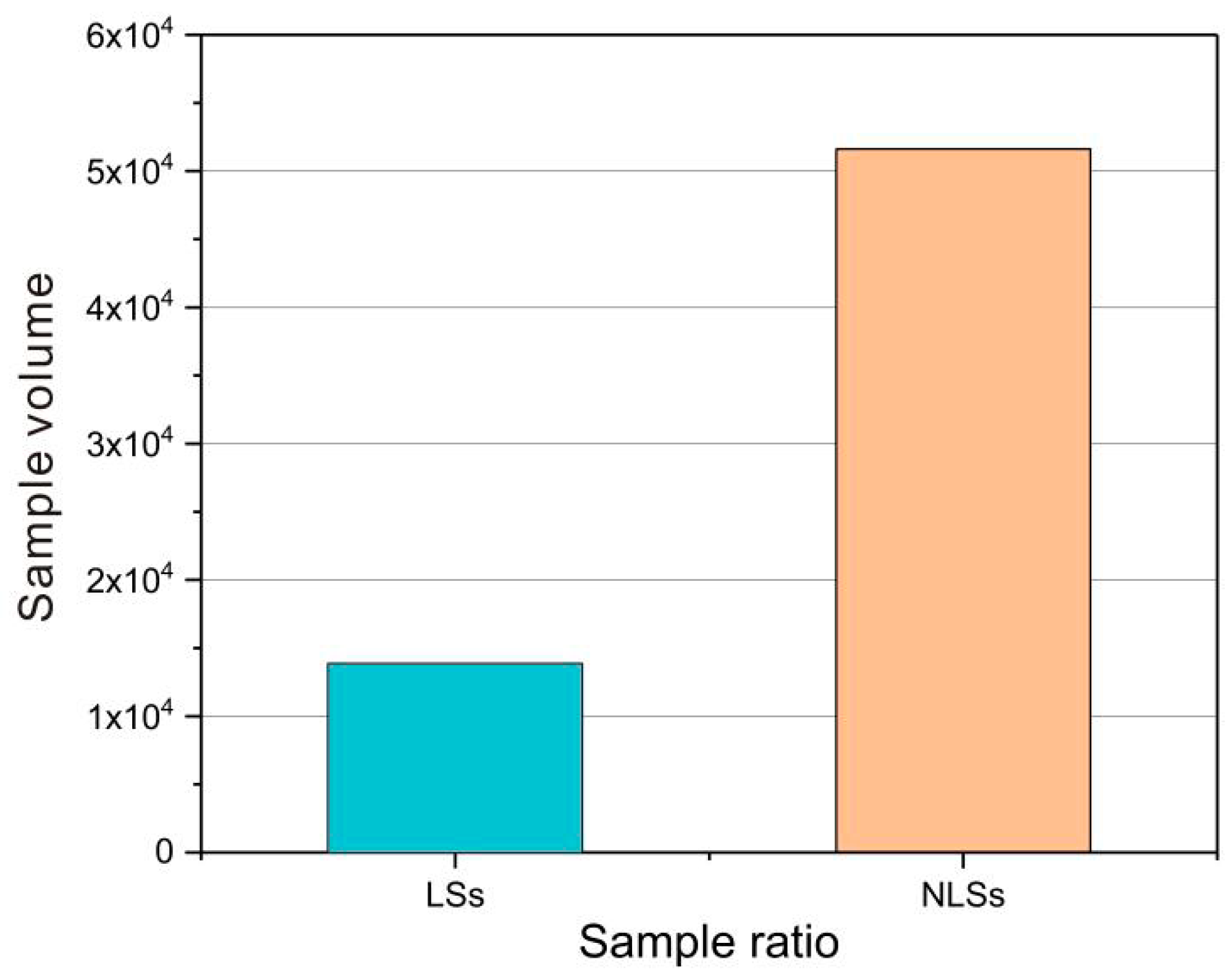


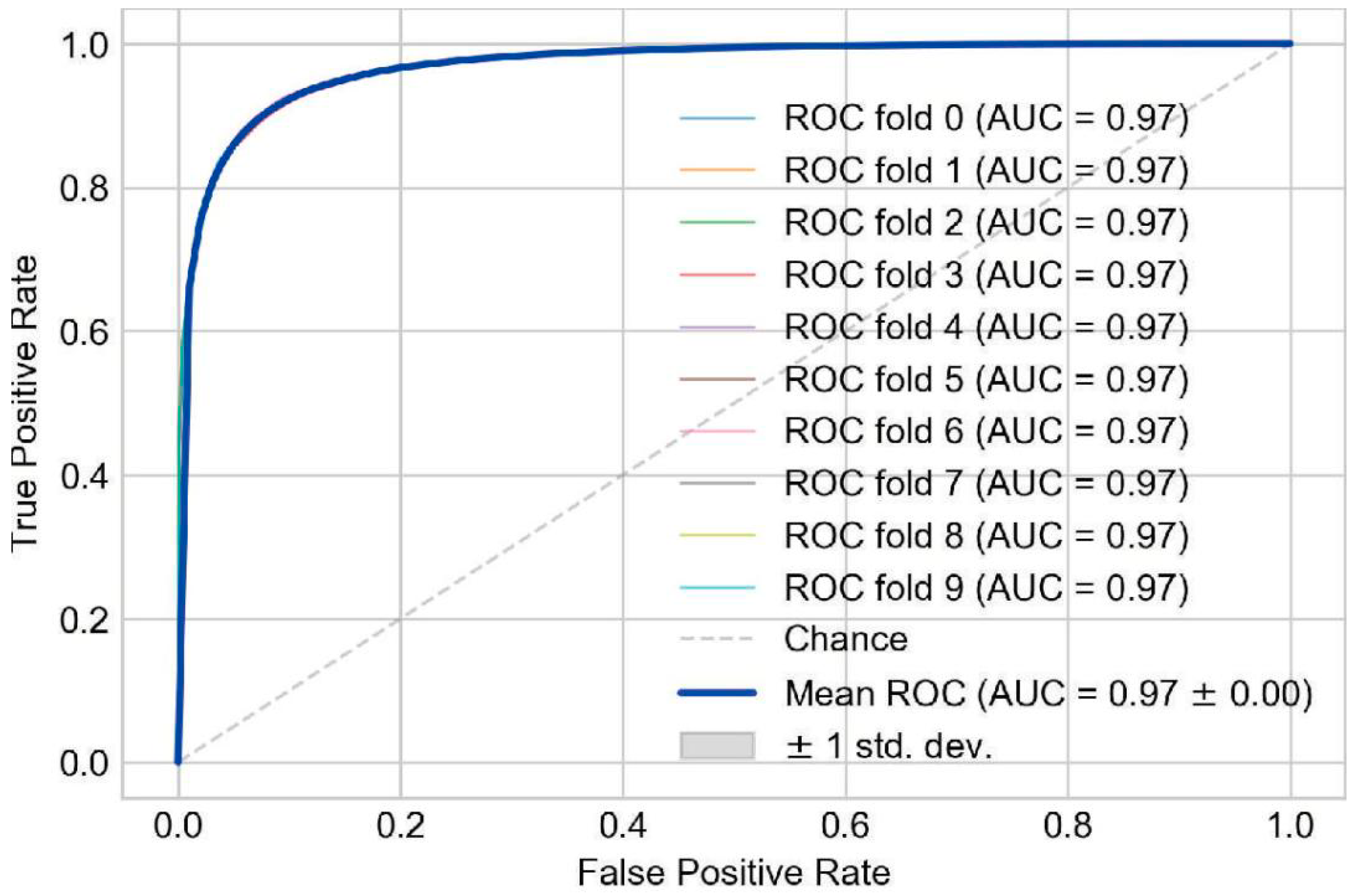
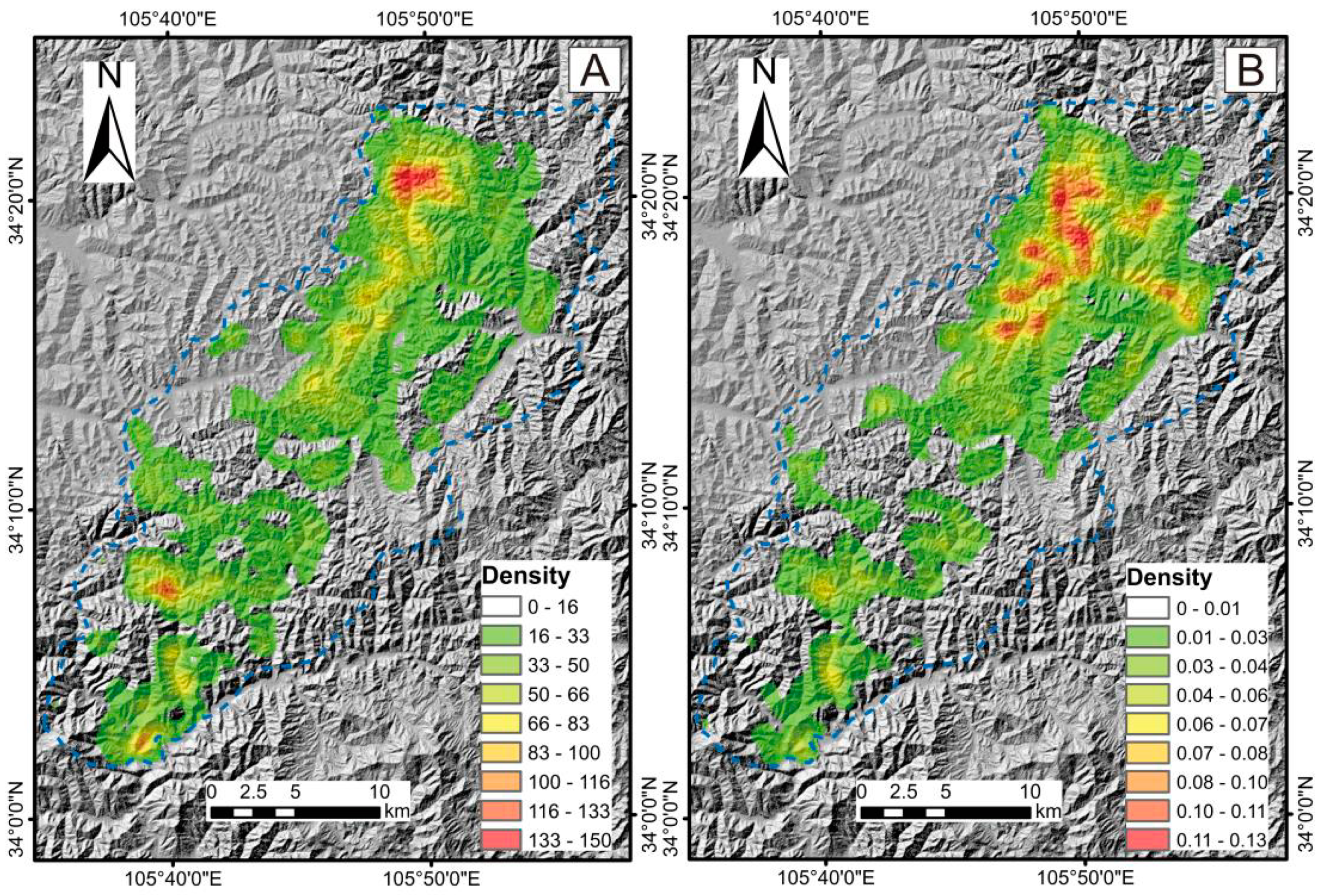
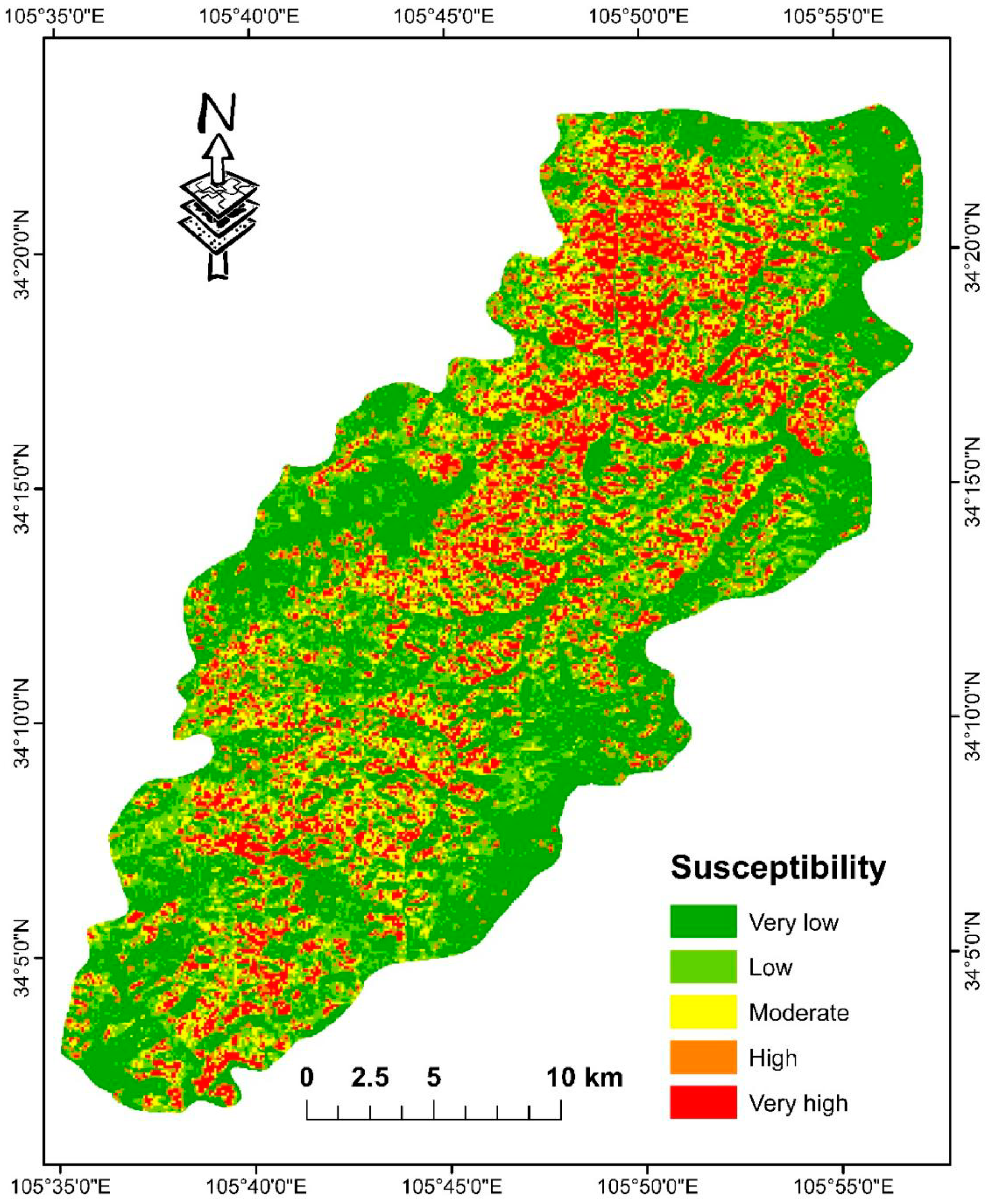
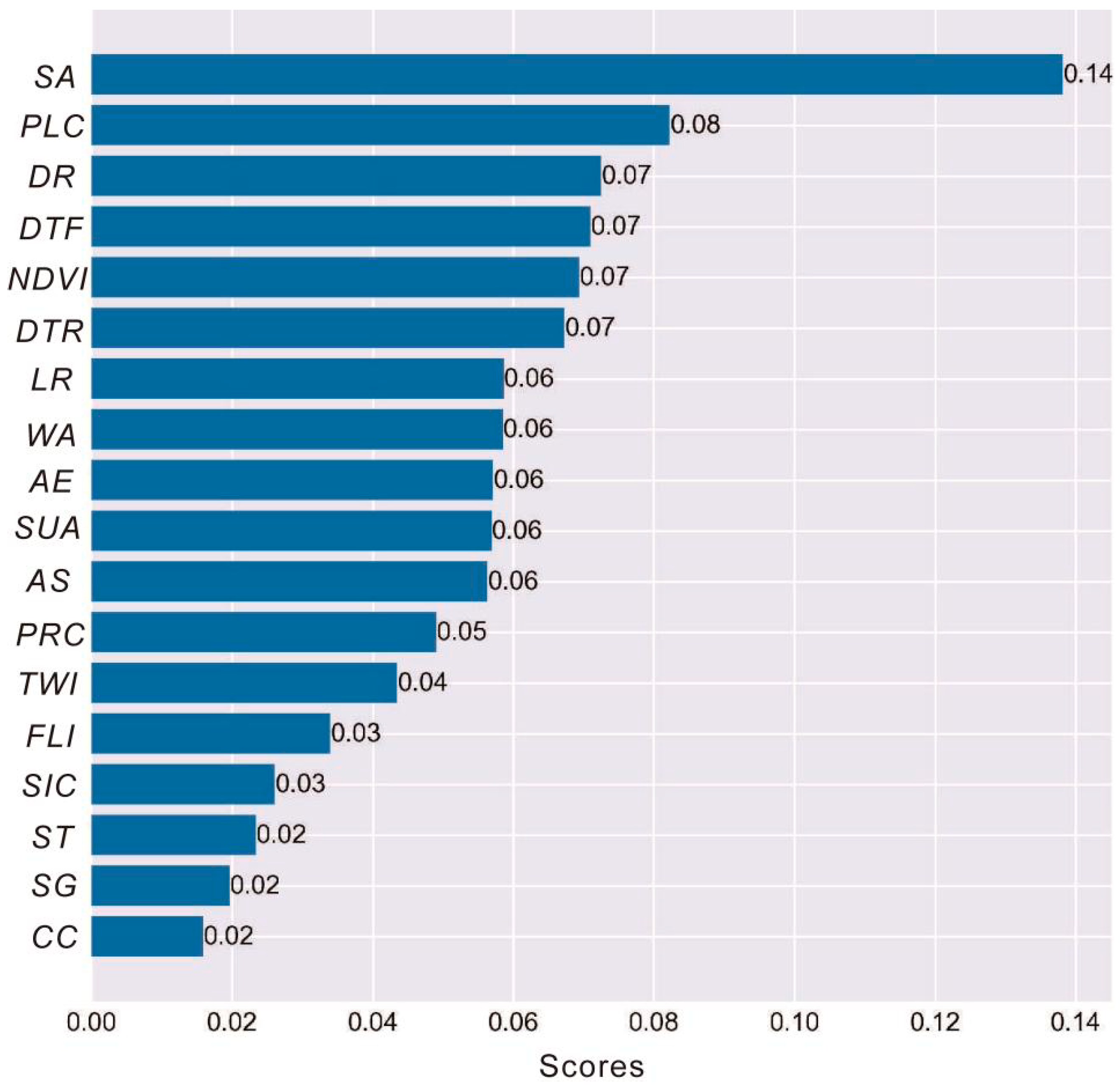

| Field | Parameter | Units | ||
|---|---|---|---|---|
| 1 | ID | Identification field | / | |
| 2 | LO | Landslide occurrence or not | / | |
| 3 | Parameters related to geomorphological conditions | AS | Average slope | ° |
| 4 | SA | Slope aspect | ° | |
| 5 | LR | Local relief | km | |
| 6 | PRC | Profile curvature | / | |
| 7 | PLC | Planar curvature | / | |
| 8 | SUA | Slope unit area | km2 | |
| 9 | E | Elevation | km | |
| 10 | TWI | Topographic wetness index | / | |
| 11 | WA | Watershed area | km2 | |
| 12 | Parameter related to material and geology conditions | NDVI | Normalized Difference Vegetation Index | / |
| 13 | FLI | Formation lithological index | / | |
| 14 | DTF | Distance to fault | km | |
| 15 | ST | Soil type | / | |
| 16 | SC | Sand content | % | |
| 17 | SG | Gravel content | % | |
| 18 | SIC | Silt content | % | |
| 19 | CC | Clay content | % | |
| 20 | SB | Soil bulk | N/m3 | |
| 21 | DR | Distance to river | km | |
| 22 | Parameter related to engineering activities | DTR | Distance to road | km |
| Predicted Label | |||
|---|---|---|---|
| Positive | Negative | ||
| True label | Positive | True Positive (TP) | False Negative (FP) |
| Negative | False Positive (FP) | True Negative (TN) | |
| Classifier Algorithm | Best Parameter | Runtime (s) | |
|---|---|---|---|
| 1 | ExtraTreesClassifier | ‘n_estimators’ = 500 | 50,615.69 |
| ‘random_state’ = 0 | |||
| ‘criterioin’ = gini | |||
| 2 | RandomForestClassifier | ‘criterioin’ = ‘entropy’ | 329,402.72 |
| ‘max_depth’ = 54 | |||
| ‘n_estimators’=500 | |||
| ‘oob_score’ = True | |||
| 3 | BaggingClassifier | ‘max_samples’ = 1.0 | 35,085.42 |
| ‘n_estimators’ = 500 | |||
| 4 | KNeighborsClassifer | ‘algorithm’ = auto | 41,816.73 |
| ‘n_neighbors’ = 8 | |||
| ‘weithts’ = ‘distance’ |
Publisher’s Note: MDPI stays neutral with regard to jurisdictional claims in published maps and institutional affiliations. |
© 2021 by the authors. Licensee MDPI, Basel, Switzerland. This article is an open access article distributed under the terms and conditions of the Creative Commons Attribution (CC BY) license (https://creativecommons.org/licenses/by/4.0/).
Share and Cite
Qi, T.; Zhao, Y.; Meng, X.; Chen, G.; Dijkstra, T. AI-Based Susceptibility Analysis of Shallow Landslides Induced by Heavy Rainfall in Tianshui, China. Remote Sens. 2021, 13, 1819. https://doi.org/10.3390/rs13091819
Qi T, Zhao Y, Meng X, Chen G, Dijkstra T. AI-Based Susceptibility Analysis of Shallow Landslides Induced by Heavy Rainfall in Tianshui, China. Remote Sensing. 2021; 13(9):1819. https://doi.org/10.3390/rs13091819
Chicago/Turabian StyleQi, Tianjun, Yan Zhao, Xingmin Meng, Guan Chen, and Tom Dijkstra. 2021. "AI-Based Susceptibility Analysis of Shallow Landslides Induced by Heavy Rainfall in Tianshui, China" Remote Sensing 13, no. 9: 1819. https://doi.org/10.3390/rs13091819
APA StyleQi, T., Zhao, Y., Meng, X., Chen, G., & Dijkstra, T. (2021). AI-Based Susceptibility Analysis of Shallow Landslides Induced by Heavy Rainfall in Tianshui, China. Remote Sensing, 13(9), 1819. https://doi.org/10.3390/rs13091819







